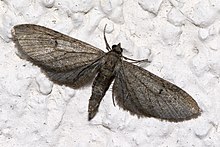Eupithecia
| Eupithecia | |
|---|---|
 |
|
| Eupithecia innotata | |
| Scientific classification | |
| Kingdom: | Animalia |
| Phylum: | Arthropoda |
| Class: | Insecta |
| Order: | Lepidoptera |
| Family: | Geometridae |
| Subfamily: | Larentiinae |
| Tribe: | Eupitheciini |
| Genus: |
Eupithecia Curtis, 1825 |
| Synonyms | |
|
|
Eupithecia is a large genus of moths of the family Geometridae. There are hundreds of described species, found in all parts of the world (45 in the British Isles alone), and new species are discovered on a regular basis.
Eupithecia species form the bulk of the group commonly known as pugs. They are generally small with muted colours and specific identification can be difficult. As a group they are easily identified by their narrow wings held flat at 90° to the body with the hindwings almost hidden behind the forewings.
The larvae of many species feed on the flowers and seeds of their food plants rather than the foliage. Many species have a very specific food plant. Some Hawaiian Eupithecia are predators of other insects (E. orichloris, E. staurophragma, E. scoriodes). They mimic twigs but when sensitive hairs on their backs are triggered, they quickly grab the insects touching them. The defensive behavior of snapping may have pre-adapted Hawaii's ancestral Eupithecia for shifting to predation from feeding on pollen. Also, insect predators that behave in this way are lacking in Hawaii's fauna.
This is a list of all described species.
...
Wikipedia
